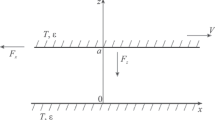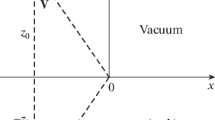Abstract
It has been shown that the fundamental results obtained in the works by Levine–Polevoi–Rytov (1980) and Rytov (1990) adequately describe the rate of radiative heat exchange and frictional force in a system of two thick parallel plates in relative motion, in full agreement with the results obtained by other authors later. A numerically calculated friction force for Drude metals turns out to be higher by a factor of 107 than the early result obtained by Polevoi. In addition, the friction force significantly increases with increasing the conductivity of the plates or increasing the relaxation time of electrons with decreasing temperature.






Similar content being viewed by others
REFERENCES
M. L. Levin and S. M. Rytov, Theory of Equilibrium Thermal Fluctuations in Electrodynamics (Nauka, Moscow, 1967) [in Russian].
S. M. Rytov, Theory of Electric Fluctuations and Thermal Radiation (Akad. Nauk SSSR, Moscow, 1953) [in Russian].
M. L. Levin, V. G. Polevoi, and S. M. Rytov, Sov. Phys. JETP 52, 1054 (1980).
V. G. Polevoi, Heat Exchange by Fluctuation Electromagnetic Field (Nauka, Moscow, 1990) [in Russian].
V. G. Polevoi, Sov. Phys. JETP 71, 1119 (1990).
D. Polder and M. van Hove, Phys. Rev. B 4, 3303 (1971).
J. J. Loomis and H. J. Maris, Phys. Rev. B 50, 18517 (1994).
K. Park and Z. Zhang, Front. Heat Mass Transfer 4, 013001 (2013).
V. B. Bezerra, G. Bimonte, G. L. Klimchitskaya, V. M. Mostepanenko, and C. Romero, Eur. Phys. J. C 52, 701 (2007).
A. I. Volokitin and B. N. J. Persson, Rev. Mod. Phys. 79, 1291 (2007).
B. N. J. Persson and Zhang Zhenyu, Phys. Rev. B 57, 7327 (1998).
A. I. Volokitin and B. N. J. Persson, J. Phys. C 11, 345 (1999).
J. B. Pendry, J. Phys. C 9, 10301 (1997).
V. E. Teodorovich, Proc. R. Soc. London, Ser. A 362, 71 (1978).
T. G. Philbin and U. Leonhardt, New J. Phys. 11, 03035 (2009); arXiv: 094.2148.
A. I. Volokitin and B. N. J. Persson, New J. Phys. 11, 033035 (2009).
J. B. Pendry, New J. Phys. 12, 033028 (2010).
J. S. Hoye and I. Brevik, Entropy 15, 3045 (2013).
K. A. Milton, J. S. Hoye, and I. Brevik, Symmetry 8, 29 (2016).
G. V. Dedkov and A. A. Kyasov, Phys. Usp. 60, 559 (2017).
K. A. Milton, R. Guerodt, G. L. Ingold, A. Lambrecht, and S. Reynaud, J. Phys.: Condens. Matter 27, 214003 (2015).
M. Bordag, G. L. Klimchitskaya, U. Mohideen, and V. M. Mostepanenko, Advances in the Casimir Effect (Oxford Univ. Press, Oxford, UK, 2009).
C.-C. Chang, A. A. Banishev, R. Castillo-Garza, G. L. Klimchitskaya, V. M. Mostepanenko, and U. Mo-hideen, Phys. Rev. B 85, 165443 (2012).
A. A. Banishev, G. L. Klimchitskaya, V. M. Mostepanenko, and U. Mohideen, Phys. Rev. B 88, 155410 (2013).
B. C. Stipe, H. J. Mamin, T. D. Stowe, Y. W. Kenny, and D. Rugar, Phys. Lett. 87, 096801 (2001).
B. V. Derjaguin, Kolloid Z. 69, 155 (1934).
Author information
Authors and Affiliations
Corresponding authors
Additional information
Translated by G. Dedkov
APPENDIX
APPENDIX
When calculating integrals in (30), (34), (38), and (40) with Drude function (44), it is expedient to write \({{\varepsilon }_{D}}(\omega )\) in the form
where \(\tilde {\lambda }\) = \(\kappa _{p}^{2}{\text{/}}{{\kappa }_{w}}\). Accordingly, formulas (31), (33), (35), (37)–(41) for quantities U1, 2, and ϕ1, 2 reduce to
where λ = \(\kappa _{p}^{2}\lambda _{a}^{2}{\text{/}}{{\kappa }_{w}}\). Expressions (32), (34), (36), and (42) should be used taking into account modifications made for U1, 2 and ϕ1, 2.
Rights and permissions
About this article
Cite this article
Dedkov, G.V., Kyasov, A.A. Friction Force and Radiative Heat Exchange in a System of Two Parallel Plates in Relative Motion: Corollaries of the Levine–Polevoi–Rytov Theory. Phys. Solid State 60, 2349–2357 (2018). https://doi.org/10.1134/S1063783418120119
Received:
Accepted:
Published:
Issue Date:
DOI: https://doi.org/10.1134/S1063783418120119




